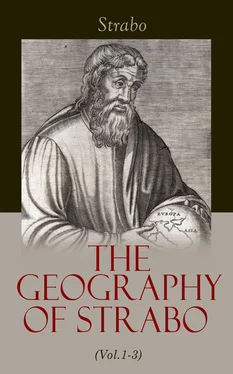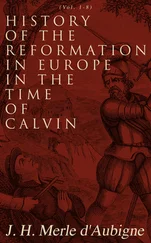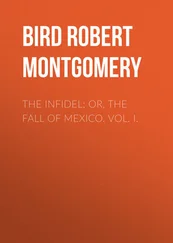12. But within-side the chain of mountains, [where these cities are situated,] there is another ridge, leaving a valley between it and Mount Algidus; it is lofty, and extends as far as Mount Albanus. 1902It is on this ridge that Tusculum is situated, a city which is not wanting in adornment, being entirely surrounded by ornamental plantations and edifices, particularly that part of it which looks towards Rome. For on this side Tusculum presents a fertile hill, well irrigated, and with numerous gentle slopes embellished with majestic palaces. Contiguous are the undulating slopes of Mount Albanus, which are equally fertile and ornamented. Beyond are plains which extend some of them to Rome and its environs, others to the sea; these latter are unhealthy, but the others are salubrious and well cultivated. Next after Albanum is the city Aricia, on the Appian Way. It is 160 stadia from Rome. This place is situated in a hollow, and has a strong citadel. 1903Beyond it on one side of the way is Lanuvium, 1904a Roman city on the right of the Via Appia, and from which both the sea and Antium may be viewed. On the other side is the Artemisium, 1905which is called Nemus, 1906on the left side of the way, leading from Aricia to the temple. 1907They say that it is consecrated to Diana Taurica, and certainly the rites performed in this temple are something barbarous and Scythic. They appoint as priest a fugitive who has murdered the preceding priest with his own hand. Apprehensive of an attack upon himself, the priest is always armed with a sword, ready for resistance. The temple is in a grove, and before it is a [Pg 356] [CAS. 240] lake of considerable size. The temple and water are surrounded by abrupt and lofty precipices, so that they seem to be situated in a deep and hollow ravine. The springs by which the lake is filled are visible. One of these is denominated Egeria, after the name of a certain divinity; however, their course on leaving the lake is subterraneous, but they may be observed at some distance, when they rise to the surface of the ground.
13. Near to these localities is Mount Albanus, 1908which is much higher than either the Artemisium or the heights surrounding it, although these are sufficiently lofty and precipitous. It has likewise a lake, 1909much larger than that of the Artemisium. Further forward than these are the cities on the Via Latina, we have already mentioned. Alba 1910is the most inland of all the Latin cities; it borders on the Marsi, and is situated on a high hill near to Lake Fucinus. This [lake] is vast as a sea, and is of great service to the Marsi and all the surrounding nations. They say, that at times its waters rise to the height of the mountains which surround it, and at others subside so much, that the places which had been covered with water reappear and may be cultivated; however, the subsidings of the waters occur irregularly and without previous warning, and are followed by their rising again; the springs fail altogether and gush out again after a time; as they say is the case with the Amenanus, 1911which flows through Catana, 1912for after remaining dry for a number of years, it again flows. It is reported that the Marcian 1913water, which is drunk at Rome in preference to any other, has its source in [Lake] Fucinus. As Alba is situated in the depths of the country, and is besides a strong position, the Romans have often employed it as a place of security, for lodging important prisoners. 1914
Table of Contents
1. After having commenced with the nations about the Alps, and the Apennine mountains which are near to these, we proceeded from thence and passed through that portion of the hither country lying between the Tyrrhenian Sea and the Apennine mountains, which incline towards the Adriatic, as far as the Samnites and the Campani. We will now return again, and describe the mountaineers, and those who dwell at the foot of the mountains; whether on the coast of the Adriatic, or in the interior. Thus, we must recommence from the boundaries of Keltica. 1915
2. After the cities of the Ombrici, which are comprised between Ariminum 1916and Ancona, comes Picenum. The Picentini proceeded originally from the land of the Sabini. A woodpecker led the way for their chieftains, and from this bird they have taken their name, it being called in their language Picus, and is regarded as sacred to Mars. They inhabit the plains extending from the mountains to the sea; the length of their country considerably exceeds its breadth; the soil is every where good, but better fitted for the cultivation of fruits than grain. Its breadth, from the mountains to the sea varies in different parts. But its length; from the river Æsis 1917to Castrum, 1918sailing round the coast, is 800 stadia. Of its cities, Ancona is of Grecian origin, having been founded by the Syracusans who fled from the tyranny of Dionysius. It is situated upon a cape, which bending round towards the north forms a harbour; and it abounds in wine and wheat. Near to it is the city of Auxumon, 1919at a little distance from the sea. After it are Septempeda, 1920Pneuentia, 1921Potentia, 1922and Firmum Picenum, 1923with its port of Castellum. 1924Beyond, is the temple of Cupra, 1925built and dedicated by the Tyrrheni to Juno, who is named by them Cupra; and after it the river Tronto, 1926[Pg 358] [CAS. 241] with a city of the same name. 1927Beyond this is Castrum Novum, 1928and the river Piomba, 1929flowing from the city of Adria, 1930and having [at its mouth] the naval station of Adria, which bears the same name as itself. In the interior is [the city of Adria] itself and Asculum Picenum, 1931a very strong position, upon which is built a wall: the mountains which surround it are not accessible to armies. 1932Above Picenum are the Vestini, 1933the Marsi, 1934the Peligni, 1935the Marucini, 1936and the Frentani, 1937a Samnitic nation possessing the hill-country, and extending almost to the sea. All these nations are small, but extremely brave, and have frequently given the Romans proofs of their valour, first as enemies, afterwards as allies; and finally, having demanded the liberty and rights of citizens, and being denied, they revolted and kindled the Marsian war. 1938They decreed that Corfinium, 1939the metropolis of the Peligni, should be the capital for all the Italians instead of Rome: made it their place d’armes, and new-named it Italica. Then, having convoked deputies from all the people friendly to their design, they created consuls 1940and prætors, and maintained the war for two 1941years, until they had obtained the rights for which they struggled. The war was named the Marsian 1942war, because that nation commenced the insurrection, and particularly on account of Pompædius. 1943These nations live generally in villages, nevertheless they are possessed of certain cities, some of which are at some little distance from the sea, as Corfinium, Sulmo, 1944Maruvium, 1945and Teatea 1946the metropolis of the Marrucini. Others are on the coast, as Aternum 1947on the Picentine boundary, so named from the river [Aternus], which separates the Vestini from the Marrucini. This river flows from the territory of Amiternum and through the Vestini, leaving on its right the Marrucini, who lie above the Peligni, [at the place where the river] is crossed by a bridge. The city, which bears the same name, (viz. Aternum,) belongs to the Vestini, but its port is used in common both by the Peligni and the Marrucini. The bridge I have mentioned is about 24 stadia from Corfinium. After Aternum is Orton, 1948a naval arsenal of the Frentani, and Buca, 1949which belongs to the same people, and is conterminous with the Apulian Teanum. 1950†Ortonium 1951is situated in the territory of the Frentani. It is rocky, and inhabited by banditti, who construct their dwellings of the wrecks of ships, and lead otherwise [Pg 360] [CAS. 242] a savage life.† Between Orton and Aternum is the river Sagrus, 1952which separates the Frentani from the Peligni. From Picenum to the Apuli, named by the Greeks the Daunii, 1953sailing round the coast, is a distance of about 490 1954stadia.
Читать дальше












![Anne Blunt - A Pilgrimage to Nejd, the Cradle of the Arab Race. Vol. 2 [of 2]](/books/750183/anne-blunt-a-pilgrimage-to-nejd-the-cradle-of-the-thumb.webp)